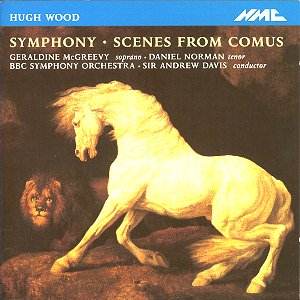Wood’s Symphony Op.21, completed in 1982,
is his largest orchestral piece so far: its four movements, paired in
each of the two large sections of the work, do not adhere to the traditional
formal scheme. The first part opens with a violent introduction (Tempesta:
Oscuro, agitato, minaccioso) of which the mood is predominantly
agitated and foreboding as if pointing to some forthcoming catastrophe.
This highly dynamic movement leads directly into the long Elegia,
the symphony’s first slow movement, in which some quotations from Mozart’s
Magic Flute are woven into the musical fabric. This long movement
opens with a long cello melody which returns later in the movement.
In the meantime other events take place : the first main theme is developed
and another big 12-note theme started by the violas will soon dominate
much of the music. A restatement of the main theme dissolves into another
quotation from The Magic Flute. The movement dies away with a
brief reference to the opening of the symphony. The Scherzo: Con
fuoco picks up the same basic material with renewed energy. Long
lines are now replaced by fragments tossed in all directions and the
music is driven along by nervous ostinati. In the Trio another
broad melody is stated by the violins. The reprise of the Scherzo eventually
subsides in tinkling sounds beneath which the brass outline the theme
of the Finale that follows without a break. The last movement, actually
a Passacaglia, is again predominantly slow although the variations
provide for much dynamic contrast. The climax (in Variation 19) is followed
by a restatement of the tinkling sounds from the Scherzo and the coda
recalls some of the earlier material before rushing to an exalted peroration.
I am in no doubt that Wood’s Symphony Op.21 is an important
piece and one of the peaks of his output. To quote from Stephen Walsh’s
excellent notes, this single-minded symphony suggests "the playing
out of some intense but unconfessed psychodrama" which is hinted
at through the several Mozart quotations. Even if one does not necessarily
see clearly through these quotations, one is gripped by the music’s
sheer intensity and passion. A masterpiece by all counts.
Scenes from Comus Op.6, first performed
in 1965, is Wood’s first large-scale work written after a handful of
chamber works, amongst others his masterly Variations Op.1
(1958) for viola and piano. Wood’s output includes numerous vocal works
among which a number of song cycles either with piano or instrumental
accompaniment. However Scenes from Comus Op.6 is his first
acknowledged piece for full orchestra but Wood’s orchestral flair and
mastery are already evident in this wonderful piece based on scenes
from Milton’s masque-with-antimasque, Comus. As Stephen Walsh
quite rightly observes, Scenes from Comus is a tone poem
based on certain contrasted elements from Milton’s masque which Wood
weaves into a continuous symphonic structure. The work opens with a
beautiful 12-note horn theme suggesting the forest in which the Lady
is lost. She seeks her brothers. Her song is swallowed by the forest.
Comus then enters and summons the forest’s evil spirits to join him
in a series of wild dances. The scene dissolves and both singers invoke
"Sabrina Fair". A short epilogue recalls the opening music
and brings the piece full circle. Scenes from Comus is
one of Wood’s finest works which reminds us that Wood is a lyricist
at heart whose seemingly effortlessly flowing melodies are hard won
indeed. It is an early, though quite magnificent example of Wood’s deeply-rooted
lyricism.
Hugh Wood is a fastidious craftsman who painstakingly
polishes his works, which accounts for his somewhat limited output of
which the musical qualities are constantly of the highest order. Wood’s
music is sincere and profoundly honest, and its integrity is one of
its most endearing qualities. These works are both magnificent examples
of Wood’s outstanding music making. They receive excellent performances,
played and sung with total commitment by all concerned under the inspired
and dedicated Andrew Davis.
In short a superb release coupling two substantial
pieces by a most distinguished composer whose music is still all too
rarely heard. Definitely, this release is in my Top Ten list and is
heartily recommended.
Hubert Culot

![]() Geraldine McGreevy (soprano)˛;
Daniel Norman (tenor)˛; BBC Symphony Orchestra; Sir Andrew Davis
Geraldine McGreevy (soprano)˛;
Daniel Norman (tenor)˛; BBC Symphony Orchestra; Sir Andrew Davis ![]() NMC D 070 [69:16]
NMC D 070 [69:16]